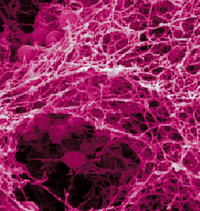Biofilms
Contact

Prof. Dr. rer. nat.
Bernd Kreikemeyer
- Professor für Molekulare Bakteriologie
am Institut für Medizinische Mikrobiologie,
Virologie und Hygiene
+49 (0) 381 494 5950
+49 (0) 381 494 5919
+49 (0) 381 494 5902
bernd.kreikemeyer{bei}med.uni-rostock.de
Importance
Biofilms consist of one or several microbial species and intercellular substance originating from the microbes. Biofilm structures cover many surfaces of the biosphere.
Biofilms represent the phylogenetically oldest and simultaneously still the most frequently encountered multicellular life form on earth.
Life within biofilm enables the microorganisms to reside at a location with constant supply of nutrients while being protected against shear stress, drying, UV light, pH shifts, toxic substances, bacteriophages, and last not least against all human defence mechanisms.
Once it has formed on human surfaces or within human tissues, biofilm can therefore hardly be removed neither by the activities of the immune system nor by externally applied therapeutic measures. As a consequence, pathologic biofilms are often associated with chronic infections, even more so when the biofilms form on implant materials.
The latter situation determine the period over which implant materials can reside within the human body without risking severe health problems for the respective patient.
Throughout the world there are many research groups engaged in elucidating the pathogenesis of biofilm infections. Periodontitis can be seen as a paradigm for a chronic biofilm infection with the consequences of tooth loss and systemic complications.
Even more frequently, research focuses on the modification of implant materials to generally prevent biofilm growth and on removal of biofilms once they have formed on medical devices. Such efforts are of great importance for the period over which joint prostheses can stay within a patient.
Working groups in this area
Main Topics
Current research projects on biofilms in the institute are
set-up and optimization of culture conditions for mixed species biofilms with periodontal pathogens
current optimization of culture techniques for investigating pathogens forming biofilms on implant materials
in situ hybridization, metabolic markers and antibody techniques for the visualization of biofilm bacteria
microscopic techniques to study the three dimensional structures of biofilms
gene expression measurements and proteomics of biofilm-organized bacteria
prevention / change of biofilm growth by surface modifications and treatments with antiseptics or probiotics

